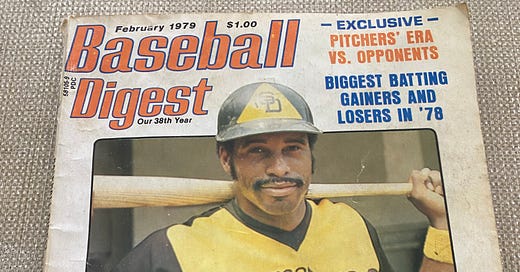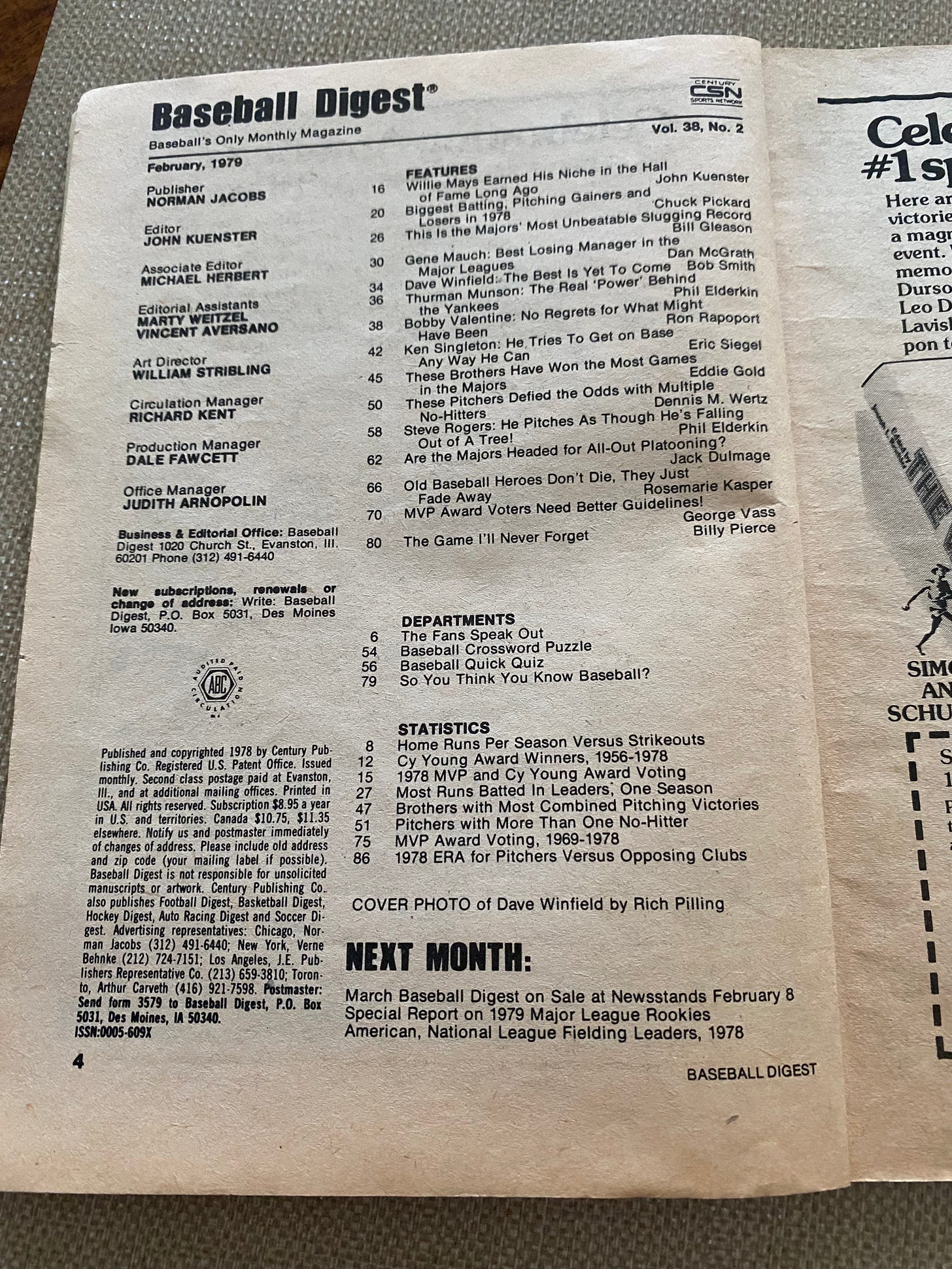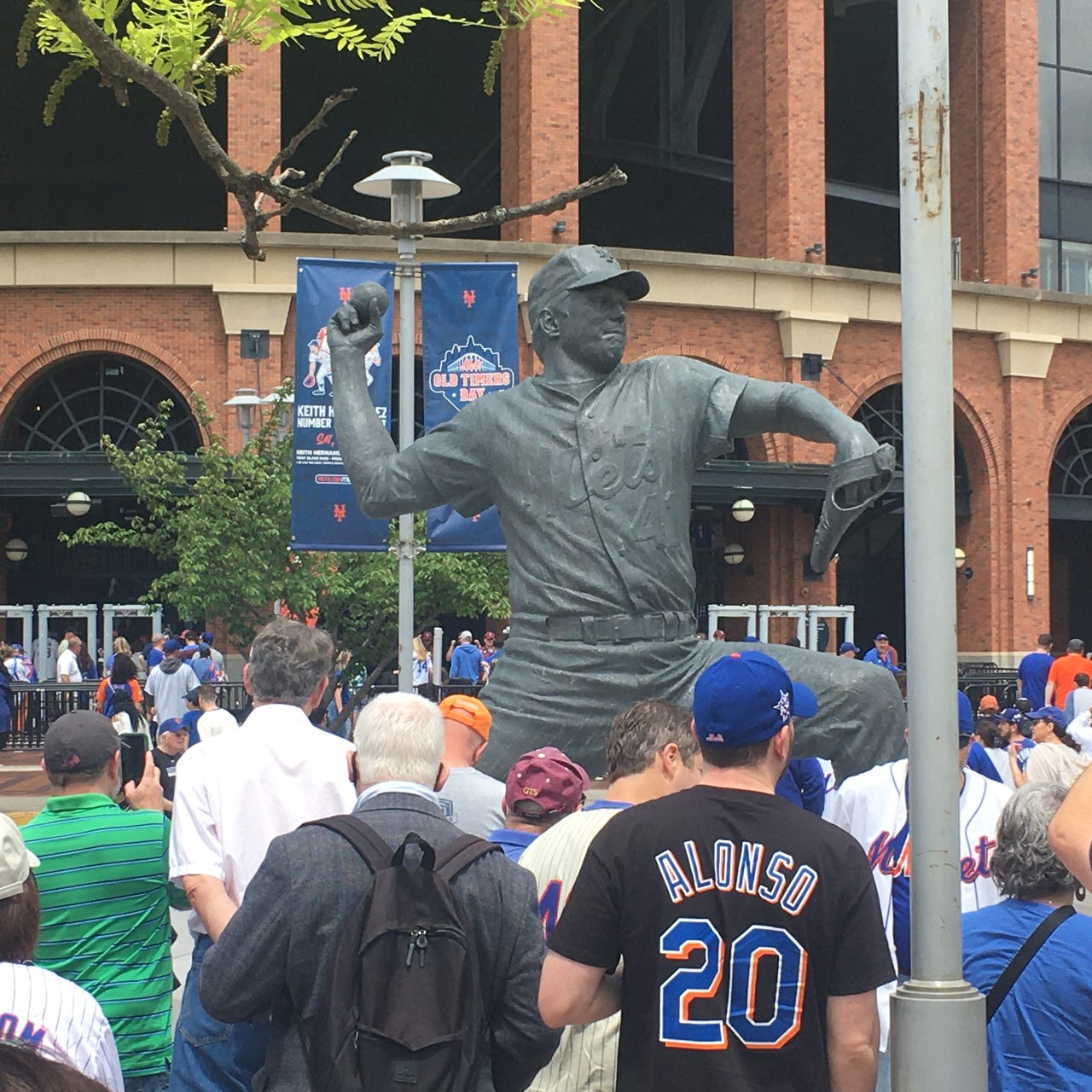February 1979
Lots of major figures in 1970’s baseball were featured in this issue, starting with the cover subject Dave Winfield. The headline on the article states that the best is yet to come, and that was certainly accurate on the eve of the 1979 season. ‘79 was arguably his best year; Winfield led the NL in both RBI & bWAR and a third place finish in the MVP vote was the highest of his career.
The piece in this month’s issue that really jumped out for me was the one that talked about the possibility of all-out platooning in baseball. In other words, as in football, baseball players could someday either be strictly offensive or defensive players. Why write that article at that time? Because Jim Rice won the AL MVP in 1978. The second paragraph states that he did so “without touching, well almost, a glove.” Huh? It’s true that Rice spent some time as a DH, but he played in the field for a total of 114 games. That in no way constitutes barely touching a glove. BTW, in case you haven’t been paying close attention, even though there is now a universal DH, there is no all-out platooning in the game and I seriously doubt that there ever will be.
What is the most unbeatable slugging record from the article of the same name? It was Hack Wilson’s single season record of 190 RBI’s (since adjusted to 191 upon further research.) That still appears to be a good call; even with the offensive explosion in the PED era, no one has come within 25 RBI of Wilson’s record. The highest total since has been Manny Ramirez totaling 165 in 1999.
An annual tradition in Baseball Digest was the chart listing the top batting & pitching gainers & losers from the previous 2 seasons. Back then I followed that closely, but upon further review it was determined by the most rudimentary data. The batting stats were simply batting average and pitching was won-loss record; more specifically games above or below .500. The 1979 list showed the limitations of this method. The second biggest batting drop? Rod Carew. 1977 was the year in which he flirted with .400. In 1978 he had another typical Rod Carew season, but because his batting average was “only” .333 his average dropped 55 points.
Describing Gene Mauch as the best losing manager in the major leagues is a great example of damning with faint praise. At this juncture he had a record of 1338-1554 across a 20 year managerial career. To be fair part of this was due to the fact that he piloted the original expansion Montreal Expos. But even beyond the fact that as a whole the teams he managed were seldom very talented, to me there is a good reason why he never led a pennant winning team. He was the ultimate micromanager, constantly overmanaging, using every bit of strategery in the book to play for one run. Well, if you play for one run, one run is what you’re going to get. It can’t be a coincidence that he was the man at the helm for 2 notorious collapses, the ‘64 Phillies and the ‘86 Angels.
Now for the lightning round: It’s poignant to see a Thurman Munson article in an issue from this year. His fatal plane crash occurred that summer. They have since been surpassed by the Niekros, but in 1979 the brother combo with the most victories was Gaylord and Jim Perry. The magazine also showed a little mischief; the article included a separate chart listing brother combos in which one of the pair failed to win a single game. The Mathewsons would have placed third, but Christy earned all 373 victories in the Mathewson family; his brother Henry was winless in the major leagues.
It was also nice to see features on a couple of star players from the time whose fame has waned a bit since. Ken Singleton has had a long run as a much acclaimed broadcaster, but I’m not sure how many people realize just how good of a player he was. And the fact that the Expos no longer exist partially explains why Steve Rogers is not as well known these days as he should be.
And of course no issue of Baseball Digest is complete without an article rehashing an ongoing debate; in this case how to define the MVP award. This month’s article features the usual bullet points. Does the winner need to be on a pennant winning team? Should pitchers be eligible? (The 1978 AL race was hotly contested between Jim Rice and Ron Guidry.) Should there be a separate award given to the most outstanding player? You could essentially cut and paste this exact same article and place it at any time, simply switch out the names. The fact that we’re never gonna really resolve this argument is both endearing and maddening at the same time.
The Cap Project - NL Central
I teased this last week, but now it’s time to get started. Without further ado, here is one man’s opinion on the appropriate cap for each Hall of Fame plaque with all emotion removed and the stipulation that there can be no blank cap cop-outs. I’ll include explanations when necessary, and also point out the instances in which the actual plaque differs from my choice. Let’s start with the NL Central:
Chicago Cubs (15): Ernie Banks, Mordecai Brown, Frank Chance, Kiki Cuyler, Johnny Evers, Gabby Hartnett, Billy Herman, Ferguson Jenkins, Ryne Sandberg, Ron Santo, Lee Smith, Bruce Sutter, Joe Tinker, Billy Williams, Hack Wilson
Cincinnati Reds (9): Jake Beckley, Johnny Bench, Barry Larkin, Ernie Lombardi, Joe Morgan, Tony Perez, Eppa Rixey, Frank Robinson, Edd Roush
Milwaukee Brewers (2): Paul Molitor, Robin Yount
St. Louis Cardinals (16): Jim Bottomley, Lou Brock, Dizzy Dean, Frankie Frisch, Bob Gibson, Chick Hafey, Jesse Haines, Rogers Hornsby, Joe Medwick, Johnny Mize, Stan Musial, Scott Rolen, Red Schoendienst, Ted Simmons, Enos Slaughter, Ozzie Smith
Pittsburgh Pirates (12): Max Carey, Fred Clarke, Roberto Clemente, Ralph Kiner, Bill Mazeroski, Dave Parker, Willie Stargell, Pie Traynor, Arky Vaughan, Honus Wagner, Lloyd Waner, Paul Waner
Differences: For the Cubs, Brown, Evers, and Tinker have blank caps. Sutter is in as a Cardinal. For the Reds, Beckley has a blank cap and Robinson is an Oriole. My Brewers selections match reality. Lots of Cardinals differences. Bottomley, Frisch, Hafey, Haines, Hornsby, Medwick, and Mize all have blank caps. For the Pirates, Wagner has a blank cap. I don’t believe an announcement has been made yet on Parker’s plaque, but it will almost certainly have a Pirates cap.
And now for my explaining. First off, a quick reminder. For decades it was the player’s choice with the Hall holding veto power just in case the player would make an indefensible selection. For example, if Wade Boggs had actually tried to go with a Devil Rays cap. Now, it’s in the hands of the Hall, but they consult with the player and generally abide by their wishes.
Bruce Sutter and Frank Robinson both went with the teams for whom they won World Series titles. I respect that reasoning, but as I said I’m trying to remove emotion if possible. Sutter really could go either way; I side with the Cubs because he pitched slightly longer in Chicago, he had more consistent success with the Cubs, he won his Cy Young with the Cubs, and his overall stats were better as a Cub. Robinson’s signature season was his 1966 triple crown year in Baltimore; he won 2 rings with Baltimore, and I would guess that when you hear his name the first image in your head is of him wearing an Orioles uniform. On the other hand, he spent more time in Cincinnati and he won an MVP award there as well. It’s a close call, but I think as a whole he was more productive as a Red.
It appears that team caps on the plaques are a fairly recent thing. For the first several decades blank caps were just as common as there were ones with team logos. Case in point, there’s no reason whatsoever for there to be no Pirates cap on Honus Wagner’s plaque. The only explanation is that whether or not a player’s plaque was associated with a specific team just wasn’t a big deal. As we move on I have found some really shocking blank caps, even from some players who spent their entire careers with one franchise.
The 2024 Critics Consensus Part 2
Here’s part 2 of my compilation of 2024 year end critics polls. As a reminder, I combined the results from an assortment of on-line surveys to try to get a sense of the most critically acclaimed albums of the year.
29. (tie) Blood Incantation - Absolute Elsewhere
29. Cassandra Jenkins - My Light, My Destroyer
28. Hurray For the Riff Raff - The Past Is Still Alive
27. St. Vincent - All Born Screaming
26. Mdou Moctar - Funeral For Justice
25. Vince Staples - Dark Times
24. Vampire Weekend - Only God Was Above Us
23. Tyla
22. Nala Sinephro - Endlessness
21. Sabrina Carpenter - Short ‘n Sweet
I’ll be back with the next set of 10 on Wednesday.
50 Years Ago - A Night At the Opera
The 4th album by Queen is the one that really cemented their international superstardom, due in large part to the fact that it was with this one where they took a giant step forward in their popularity in the United States. The range of sounds on the record is immensely broad, a point proven by the fact that the two big hits on the album could not possibly sound any different from each other. Listening to the record from beginning to end you wouldn’t think that it was all produced by the same band.
It is a very representative Queen album, for better or worse. For all of their strengths, they could also be maddeningly self indulgent. When their over the top tendencies worked, it resulted in Bohemian Rhapsody. When it didn’t, the result is The Prophet’s Song, the kind of track that makes you quickly reach for the fast forward button. It’s for this reason why as much as I respect Queen, and they have a large number of songs that I absolutely love, I hesitate to place them as highly on my personal pantheon than the general consensus does.
Speaking of Queen songs that I love, You’re My Best Friend might be my #1 favorite. It is a perfect showcase for each of the 4 members of the band. Freddie Mercury has just the right vocal tone; the song doesn’t call for any histrionics. Similarly, Brian May’s guitar work is low on his usual flash, but his more subtle work serves the song well. Roger Taylor’s drums pound, and John Deacon wrote such a lovely song and he plays that immediately recognizable organ line.
As mentioned, it’s stunning to hear how many different types of music the band tackles on this collection. There are the requisite basic rockers, such as I’m In Love With My Car, or Sweet Lady, but there are jazz inflections heard here, even an old timey sea shanty, and the album concludes with a version of God Save the Queen.
And of course the centerpiece of the album is Bohemian Rhapsody. I was 9 years old when this album came out, so I was immediately drawn to the “mamma Mia’s” and all of the operatic flourishes. It sounded like a fun novelty record to me, I did not have the perspective to understand how game changing it was when it came out. A nearly 6 minute long song with 3 distinct sections, somehow becoming a big hit on American top 40 radio? That is radical. Never mind the fact that as overplayed as it might be, and how much of a cliche it is as a drunken singalong, there is no denying just how fantastic of a song it is.
IMHO this is Queen’s single greatest album, although I’m not exactly making a controversial hot take when I say that.
Closing Laughs
That will do it for today. Have a great week everyone, and let’s do this all again on Wednesday. See you then.






